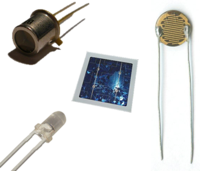
Photo from wikipedia
Biosensors that detect and convert biological reactions to a measurable signal have gained much attention in recent years. Between 1950 and 2017, more than 150,000 papers have been published addressing… Click to show full abstract
Biosensors that detect and convert biological reactions to a measurable signal have gained much attention in recent years. Between 1950 and 2017, more than 150,000 papers have been published addressing the applications of biosensors in different industries, but to the best of our knowledge and through careful screening, critical reviews that describe hydrogel based biosensors for biomedical applications are rare. This review discusses the biomedical application of hydrogel based biosensors, based on a search performed through Web of Science Core, PubMed (NLM), and Science Direct online databases for the years 2000–2017. In this review, we consider bioreceptors to be immobilized on hydrogel based biosensors, their advantages and disadvantages, and immobilization techniques. We identify the hydrogels that are most favored for this type of biosensor, as well as the predominant transduction strategies. We explain biomedical applications of hydrogel based biosensors including cell metabolite and pathogen detection, tissue engineering, wound healing, and cancer monitoring, and strategies for small biomolecules such as glucose, lactate, urea, and cholesterol detection are identified.
Journal Title: Polymers
Year Published: 2017
Link to full text (if available)
Share on Social Media: Sign Up to like & get
recommendations!